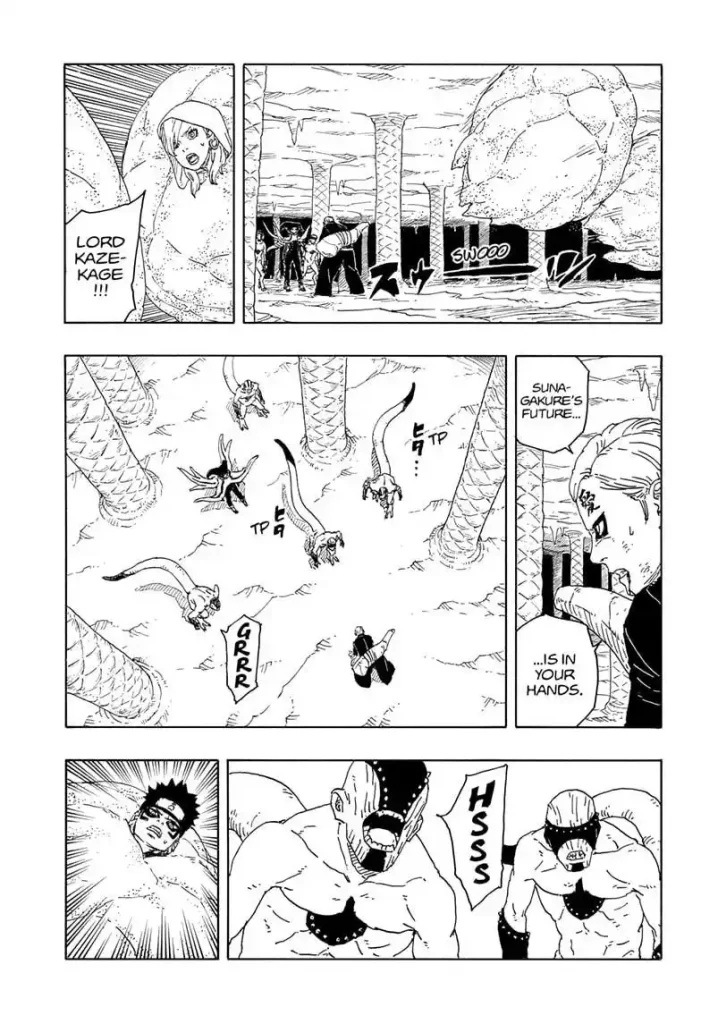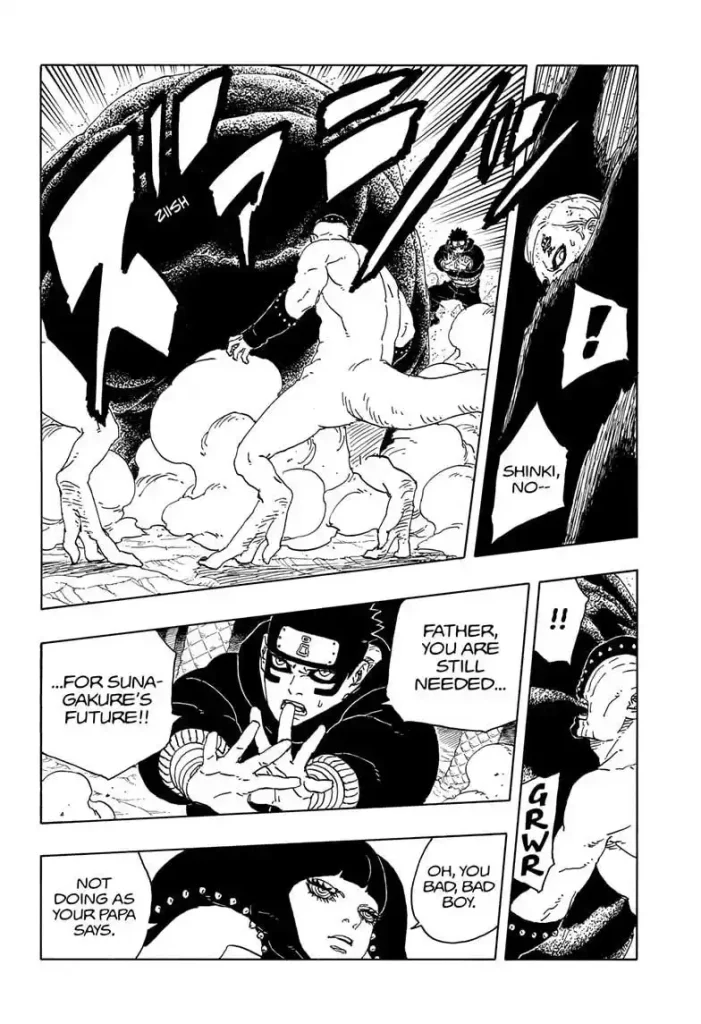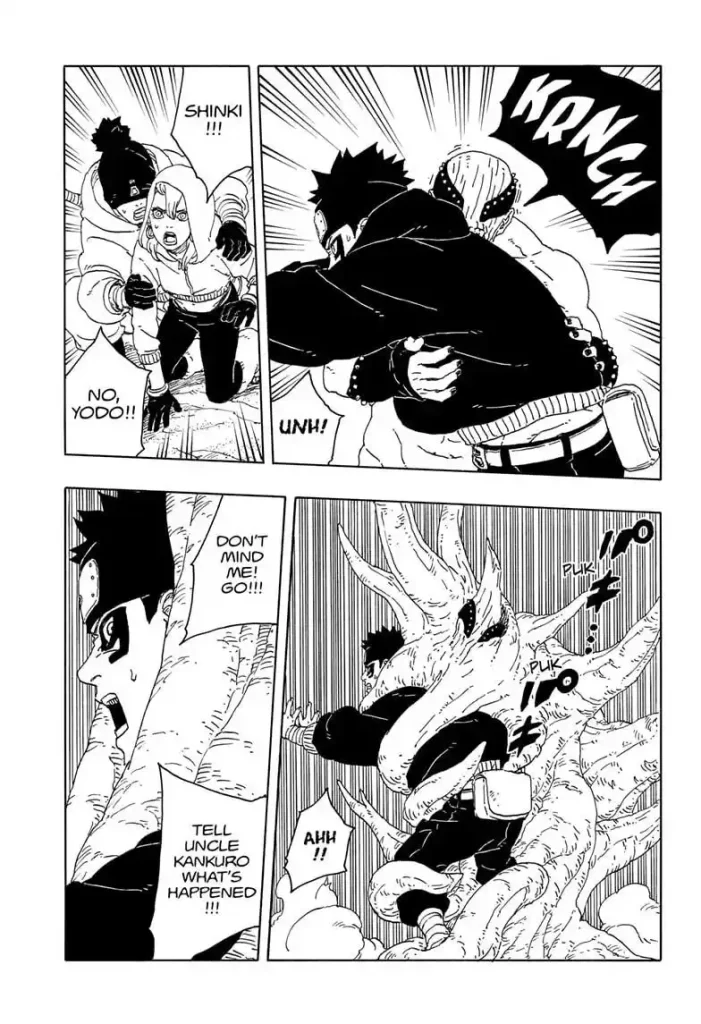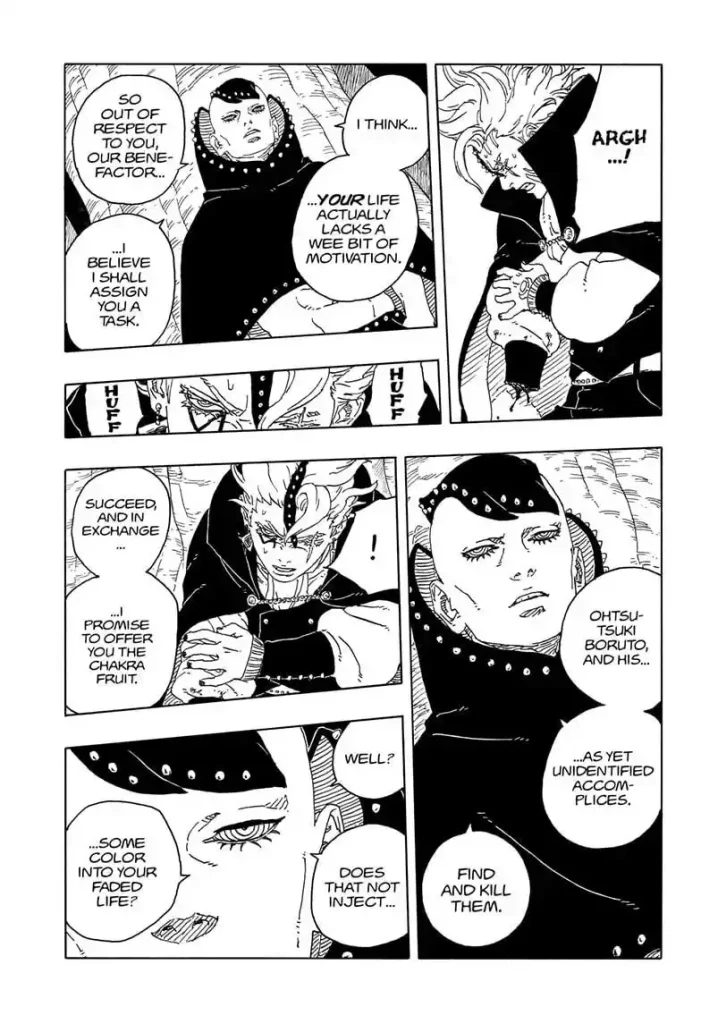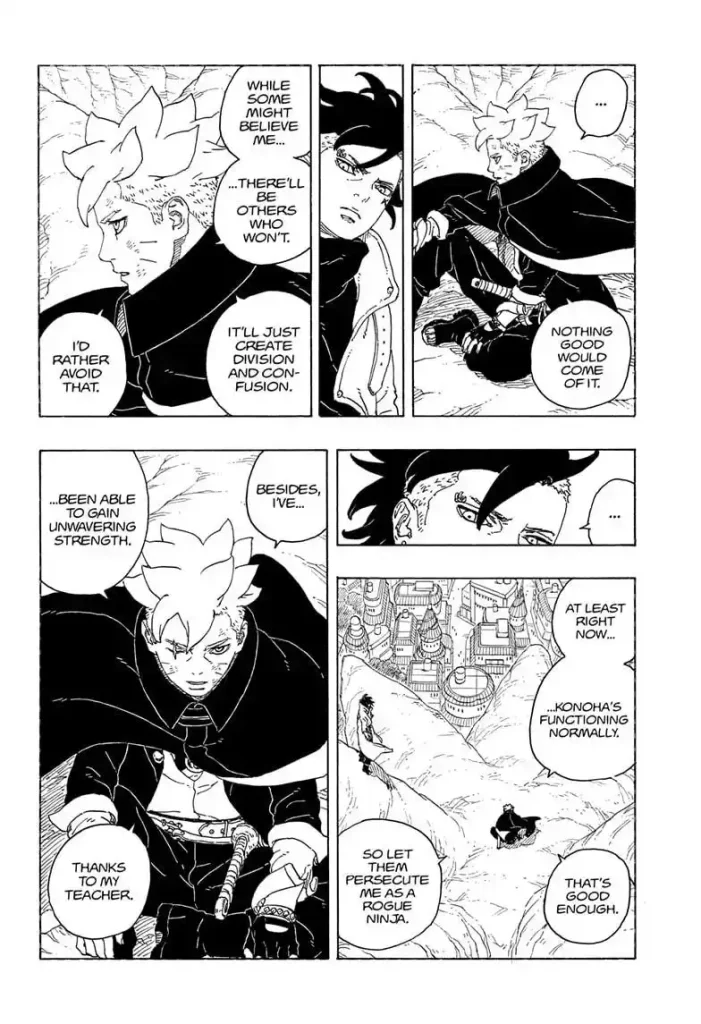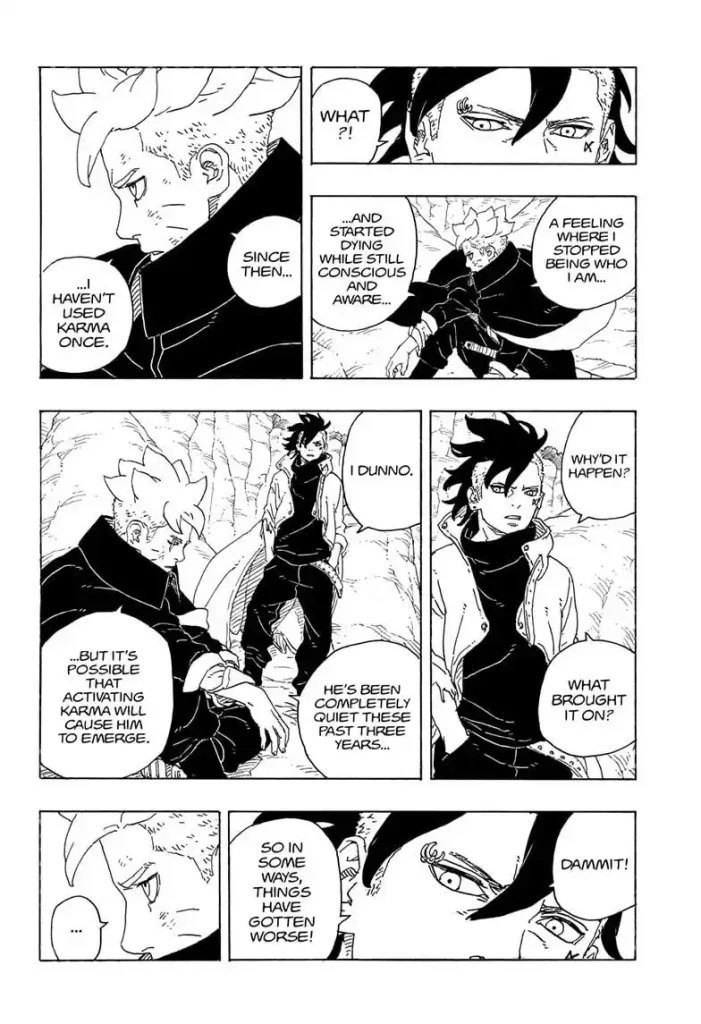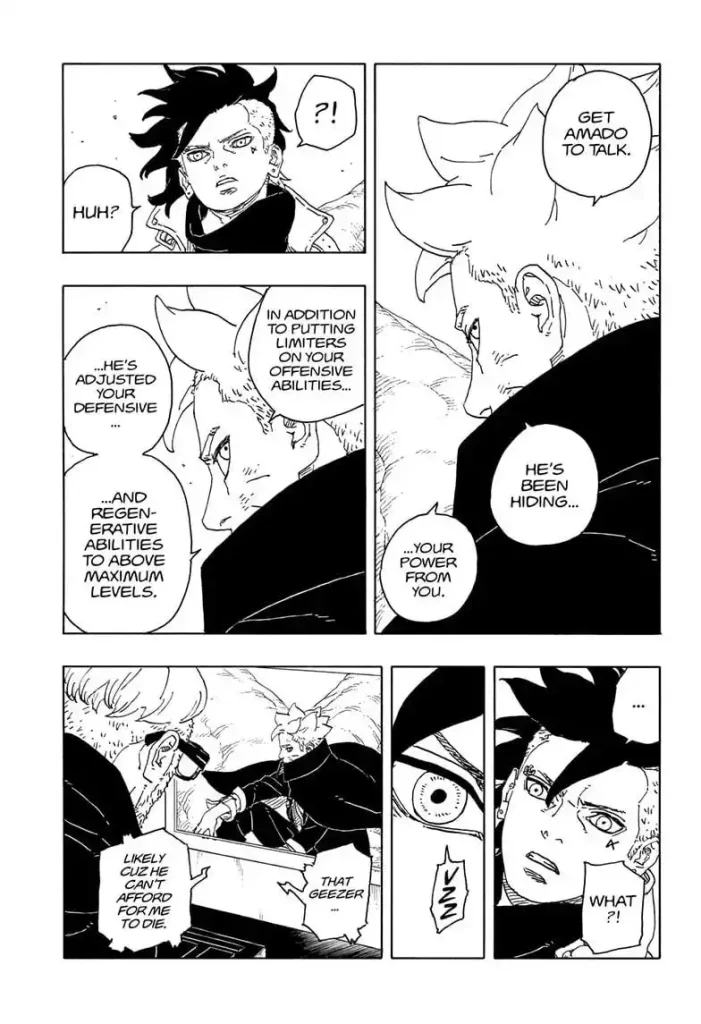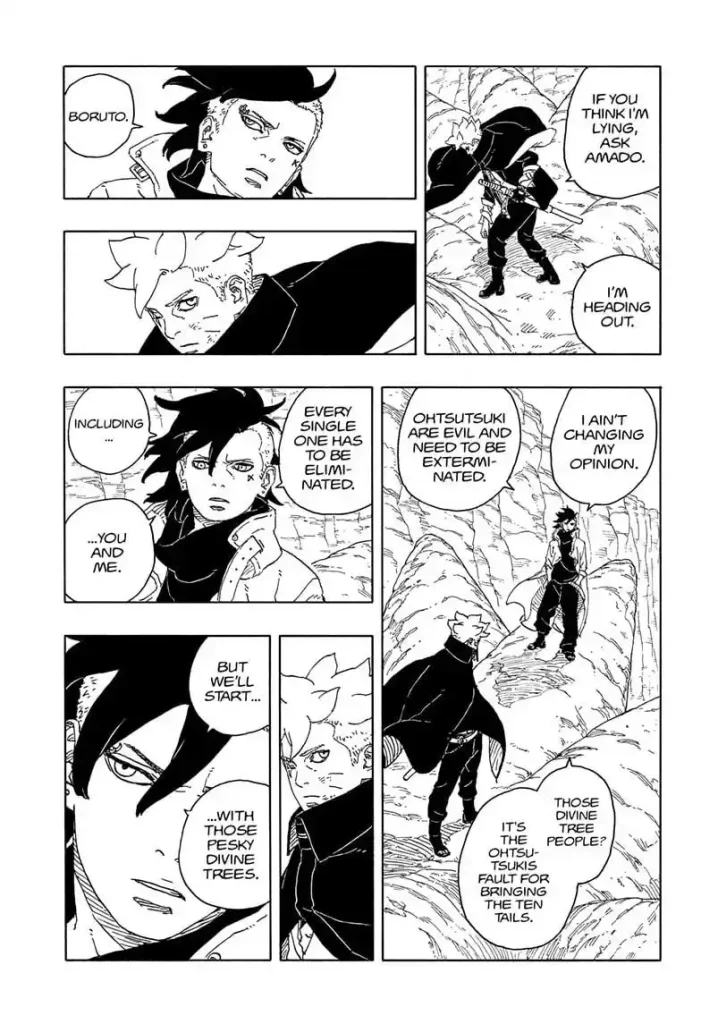Read Boruto Two Blue Vortex Manga, Chapter 15 (A Vibrant Life) Online In High Quality For Free

Momoshiki Returns – Boruto & Kawaki Team Up – Read: Boruto Manga Online
Gaara’s Heroic Stand Against Matsuri: Protecting Shinki and the Future of Sunagakure
With Boruto: Two Blue Vortex Chapter 15, things have escalated again as the stakes continue to rise. In the last chapter, Boruto escapes Konoha, and Shikamaru agrees to assemble a search to track him down. Naturally, you’d think Boruto was far from the village by now. However, in reality, Boruto stayed in the village behind the Hokage office, sitting at Naruto’s Hokage Monument face, watching over the village as he waited for Kawaki. But we’ll get into that juicy detail about their conversation later.
We open Chapter 15 of the Boruto manga with a flashback showing the battle of Matsuri vs. Gaara, which resulted in Shinkibeing turning into an awakened Shinju. Interestingly enough, the battle takes place deep within one of Orochimaru’s hideouts in the Land of Wind, evident by the snake-skin-patterned columns in the hideout. This is because both Matsuri and the small team led by Gaara have been tracking Boruto’s location. Still, they’ve been unsuccessful due to Kashin Koji’s advanced Genjutsu hiding the entrance. As a reminder, Orochimaru’s hideouts are massive underground mazes with dozens of hidden passages, as we learned in the Tiny Bridge Arc of Naruto. This explains why Koji went the extra mile to hide himself and Boruto.
While we don’t know how close the Sunagakure Shinobi and Matsuri got to where Kashin Koji was hiding, we know that the battle is very intense. Shinki and his other two adopted siblings are trapped inside Gaara’s sand cocoons, begging to be allowed to fight alongside him—to die alongside him—because Gaara refuses their help. He reached Sasuke’s same conclusion in Boruto: Two Blue Vortex Chapter 5 when he battled Code and his Ten-Tails army. Just as Sasuke told Boruto to flee because they couldn’t win, Gaara is saying something similar to Shinki, Yodo, and Araya.
Here, we see a continuation of a theme from Naruto: the concept of the King—the next generation that must be protected. The younger generation often doesn’t grasp the King’s importance due to youth ignorance. They think the King is the Hokage or even the village itself. But over time, Shikamaru understood that the King refers to the next generation, which needs to be nurtured. Sasuke also understood this for Borutoand Sarada in his actions in Chapter 5. In Chapter 15 of Boruto manga, Gaara understands this for Shinki and his two adopted children.
Despite suffering a serious wound to his stomach, Gaara continues to fight, using his chakra to protect the children. He intends to fight Matsuri while still ensuring the kids’ safety. This moment is poetic when you consider that this is the same Gaara from Naruto Part 1, who once didn’t care whether people lived or died if he viewed them as weak. Back then, they were expendable. Yet here, Gaara is protecting people his younger self would have killed without hesitation simply because they were in his way.
When Matsuri tells Gaara to think only of himself and leave her to continue searching for Boruto and his helper, Gaara refuses to back down. The lives of the children matter most to him in this moment. Using the last of his power, Gaara sends the kids flying to safety, intending to fight a 5-vs-1 battle against Matsuri and her four Claw Grimes. Gaara stands tall, drawing strength from the power of someone who is not just a Kage but also a parent—someone willing to sacrifice everything to allow the next generation to flourish.
However, things don’t go exactly as Gaara intended. Shinki uses his Magnet Release Kekkei Genkaito to shatter Gaara’s jutsu in a last-ditch effort. Just when it appears that Gaara is about to fall—too injured and tired to continue—Shinki seals Gaara inside a Magnet Release Sealing Jutsu. Gaara is furious because Shinki is doing the opposite of what he was ordered to do, not as a father, but as the Kazekage.
Shinki’s actions reflect the mindset of a young Asuma, who left Konoha to join the Guardian Shinobi 12, and the early mindset of Shikamaru during the Akatsuki Suppression Arc. Both believed that the Kage was the most important figure. Shinki believes his village needs its Kazekage more than he needs his father. Tragically, his actions lead him to be eaten by one of the Claw Grimes, turning into a tree. With his last words, Shinki urges Yodo and Araya to flee and inform Kankuro, the acting Kazekage, of the situation.
Now, let’s talk about what happened to Gaara himself. Even more impressive is that Shinki, even after showing his teammates their orders, keeps his hands stretched out, using chakra to maintain the Magnet Sealing Jutsu to protect his father. He keeps it going even after he has fallen unconscious. It is incredibly impressive when you understand what’s happening, so let me explain further.
Shinki is acting similarly to Tsunadeduring the Pain Arc. Remember when Nagato took all the chakra from the Six Paths of Pain and focused it on the Deva Path, destroying the village with one attack? That was the chakra of six people combined into one. Tsunade, not only taking the damage from all Six Paths of Pain, continued to send chakra to Katsuyu to protect the thousands of villagers still alive from the attack. Even after she fell unconscious, she subconsciously sent a chakra to Katsuyu in her mummified state because Katsuyu is directly linked to the summoner’s chakra, which, in this case, was Tsunade. The moment Tsunade ran out of chakra, Katsuyu would be dismissed.
Shinki, through sheer willpower, is continuing to maintain his Sealing Jutsu on Gaara. This impresses Matsuri when she inspects the jutsu and realizes she cannot break through it no matter how hard she tries. She notes Shinki’s potential, as he can maintain the sealing jutsu even while unconscious, and the seal won’t come undone as long as Shinki is alive.
Interestingly, we are now down to two Kage who have been eliminated since Isshiki first appeared. Kawaki sealed Naruto away, and now Gaara has been sealed away by Shinki. This is an interesting observation to keep in mind because, in the anime adaptation of Naruto Gaiden: The Seventh Hokage and the Scarlet Spring(around Episode 242), when Naruto tells the Kage about the threats that are stronger than the Kage and asserts that the next generation will be ready to protect their world if the old generation cannot, the Kage scoff at him. And now, we’re down to three of the five Kage who were in that room, still standing.
We then transition away from the flashback and back to the present, where Kankuro pleads with Konoha for help, saying that any intel they have could be useful in rescuing Gaara and, most importantly, Shinki. However, all Shikamaru can offer is a warning. If they detect a chakra signature that matches Shinki’s, they must realize it’s not Shinki but rather an enemy and treat it accordingly. Konoha had just gone through a similar situation with Hidari, whose chakra signature mimicked Sasuke’s. If not for Boruto Uzumaki, Hidari would have killed several Konoha shinobi.
After finishing his conversation with Kankuro, Shikamaru turns his attention to Sarada and Class Rep. But here’s where we see the brilliance of Shikamaru on display: he tells Sarada and Class Rep that he’s going to speak with Boruto because they need information. However, he’s not talking to them—he’s addressing the toad in his office, which sits beneath his desk. It’s a direct message to Kashin Koji: “Get word to Boruto. We need to talk.” If Boruto has already left the village and is with Kashin Koji, he knows he should return to Konoha. Shikamaru is careful because he knows Eida could be watching, either now or later, using her Senrigan.
Code vs. Jura: The Power Struggle Over the Ten-Tails in Boruto: Two Blue Vortex
Meanwhile, Ryu is speaking with Jura, who has once again assumed a leadership role, directing the Shinju along the path they should take. Jura emphasizes the importance of having a name, but what stands out is that Ryu appears more intelligent than the other Shinju, who their instincts must guide. Just as Jura showed a higher level of intelligence, we’re seeing the same in Ryu. He processes information quickly and catches Code off guard, using his Iron Sand to rip Code out of the cube where he had been hiding, using his Claw Mark Jutsu. Shinki prepares to kill Code, but Jura spares Code’s life, given that Code was the one who created them. However, the pleasantries end there—Jura is now in control.
The last time we saw Code in Chapter 4 of the Boruto manga, he told Boruto that he was content to let the Shinju do all the work for him. He’s been hiding ever since, and now we know where he’s been—watching everything via the claw marks in the hideout. The conversation between Jura and Code heats up quickly. Code grows furious when Jura tells him that finding an Otsutsuki, specifically Boruto or Kawaki, is not high on his priority list. Jura has other matters he wants to attend to before going down that path and even implies that he, not Code, wants to consume the Chakra Fruit. This enrages Code.
This ties back to Boruto’s warning to Code in Chapter 2:Destroy the Ten-Tails now while you can, or they’ll become too powerful to control. Until now, the Ten-Tails have sought to devour based on their nature alone, but Jura has shown startling growth as a human form of the Ten-Tails. He has developed desires and a thirst for knowledge and is gaining new sensations. He indirectly questions Code’s motives—why should Jura be the one to harvest the Chakra Fruit for Code when Jura himself could consume it?
This is a huge red flag, signaling that Jura is becoming uncontrollable. Kashin Koji and Boruto’s warnings about Jura now make more sense—he’s dangerous because he can’t be contained, not even by the person who created him. Jura tells Code he’s free to go after Boruto and kill him, but Kawaki is the one Jura is interested in consuming. This angers Code and gives us insight into how advanced Jura’s mind has become.
As we all know, Jura loves to read. He’s essentially enacting the strategies seen in the 48 Laws of Power, using Code to do his dirty work while he pursues other passions before harvesting the Chakra Fruit. Jura is manipulating Code, taking advantage of Code’s built-in hatred for Boruto. Even though Code realizes he’s being used, he’s too blinded by pride to grasp what’s happening fully, and that makes what follows truly heartbreaking—if you’re a Code-fan.
Code activates his Karma Seal to prepare for battle against Jura, driving his arm into the Claw Mark to subdue Jura by force. However, we immediately see what both Borutoand Eida meant in the past. Boruto warned Code, saying, “Hey, you’re not going to be able to annihilate these Shinju once they awaken unless you help me kill them now.” Eida advised Kawaki not to underestimate these Shinju, calling them “monsters” and saying they were in a different league than Code. These warnings were not exaggerations.
Within moments, Jura fires a Bijuu Dama from his Rinnegan, destroying Code’s arm and forcing him to place a Claw Mark over it to serve as a tourniquet to stop the bleeding. To add insult to injury, Jura tells Code that he’ll give Code’s pathetic life meaning by allowing him to hunt down Boruto and whoever is helping him. They decide that Jura will give Code the Chakra Fruit while Code snarls and panics.
During this exchange, Mamushi (made from Bug’s chakra) laughs at Code’s suffering, enjoying seeing the person who once bullied and threatened him being pushed to his breaking point. This is fitting, considering Mamushi is named after the most venomous snake in Japan, a viper known for sitting silently, waiting to strike. The bug was a pun on “computer bug,” as all the Kara members had tech-related names. The bug also alluded to literal insects that scurry away, and now Mamushi is watching Code suffer with satisfaction.
Even though Code tries to maintain some level of pride and control by vowing that he’ll be the last one standing, he runs off again with his tail between his legs, doing someone else’s bidding. Likely, Code knows that Jura has no intention of giving him the Chakra Fruit. This whole exchange between Jura and Code boils down to a show of force to assert dominance. Jura essentially says, “I’m in control.” To use an analogy, Code is the bottom girl working for a pimp, going out to make money, while Jura is the pimp who takes it. Jura tells Code, “Go kill Boruto, and maybe I’ll give you the Chakra Fruit.”
Right now, Jura is in complete control.
We then learn that not only does Ryu want to kill Code (which Jura doesn’t object to, as he views Code as expendable), but Ryu’s target is also Gaara, who is currently sealed away. This makes it even more likely that we’re heading toward another Rumble in the Land of Wind, which means Kashin Koji better start packing and get ready to move Boruto and himself before Code and Ryu arrive.
Boruto and Kawaki’s Confrontation at the Hokage Monument: The Tension Builds in Two Blue Vortex Chapter 15
Meanwhile, Boruto is sitting on the Hokage Monument. Behind him is the Central Business District, and in front of him is Old Konoha, where Naruto grew up, including the Hokage Office and the Ninja Academy. Boruto is sitting at his father’s Hokage Monument head, and there are two very poetic things going on here—one is foreshadowing, and the other is purely poetic.
First, Boruto sitting at his father’s monument is a clear callback to Naruto in Naruto: The Seventh Hokage. In that story, Naruto often sits on Minato’s Hokage’s head, looking down over the village and thinking deeply to clear his mind. This is a clear sign of “like father, like son,” which is very poetic. It’s also foreshadowing because Boruto and Kawakiare are now in positions similar to their final battle in the flash-forward sequence from Chapter 1 of Boruto: Naruto’s Next Generations. Boruto isn’t on one knee like in the flash-forward; instead, he’s sitting, while Kawakiis, further up the Hokage Monument, is standing. This sets the tone for what’s about to unfold, as this conversation between Boruto and Kawaki becomes deep and changes how we view Boruto’s character.
Boruto asks Kawaki, “Are you alone?” fully aware that even if Kawaki says yes, the answer is no, as Eida watches everything through her Senrigan. Kawaki cuts to the chase, asking Boruto why he didn’t “snitch” on him. The answer Boruto gives is a further sign of his maturity. He tells Kawaki that revealing the truth—that Kawaki framed Boruto for the murder of his parents, who are actually sealed away—would only lead to civil war. Some, like Shikamaru, would believe Boruto, while others, like Ino, would refuse to accept that their memories had been altered. It would cause more harm than good, so Boruto believes letting people remain ignorant of the truth is better.
This is similar to how Kakashi, upon learning about the Uchiha Massacre, concluded that revealing the truth would only worsen the village’s situation. It’s a dark commentary on human psychology but also correct. People deserve to know the truth, but it is just as important as the truth itself when it is revealed. Sometimes, lies are a form of protection, a mercy, to shield someone from a painful reality. We don’t fully know where Boruto stands on this, but we do know that he has the maturity and wisdom to understand that handling this situation the wrong way could cause everything to fall apart.
Boruto even credits his mentor, Sasuke, for helping him reach this mature conclusion. He’s willing to bear the hatred of the village if it means keeping it functioning as it should. Boruto is now being chased as a Rogue Ninja and a Kage Killer, which is heartbreaking. He’s forced to flee the only home he’s ever known, doing it to protect the village and his brother—the same brother who wants to kill him.
But as we’ll see, Boruto’s relationship is still very complicated. Boruto tells Kawaki that he believes Boruto can’t control Karma because Boruto is still afraid of it. We learn why this is—and it’s incredibly sad.
Two years ago, during the battle between Boruto and Code, where Sasuke was struck down, Boruto’s Karma activated for the first time, and he felt Momoshiki begin to take over his body. Boruto was conscious of it the entire time, and it terrified him.
Boruto has not used Karma again because he can’t control it. He is afraid of it, but he’s losing sleep at night, knowing that deep inside him, Momoshiki still exists. This is important to keep in mind for two reasons:
- At the end of Boruto: Naruto Next Generations, many people confuse Momoshiki bringing Boruto back to life to mean he can’t hijack Boruto’s body. That is not true. He can, but he just cannot resurrect in his old form. Think of Momoshiki as he fought Naruto and Sasuke—he can never return to that. However, he can hijack Boruto’s body in the form of what fans call BoruShiki. That is still possible.
- Boruto and Momoshiki’s thoughts and consciousness were beginning to merge at the end of Boruto Part One. Even though Boruto is suppressing Momoshiki, that “daemon” is still deep inside him, which troubles Boruto to his core. Kawaki states the quiet part out loud—that things have gotten worse from where they were three years ago. Boruto quickly shifts the focus to Jura, telling Kawaki that they need to team up if they will survive what is coming. Kawaki knows this is correct but doesn’t let Boruto strawman his way out of the earlier conversation. The most important topic they were discussing was Boruto’s Momoshiki problem.
This is where Boruto places an impossible burden on Kawaki by saying, “If at any point after we defeat the Shinju, Momoshiki takes over my body, I want you to kill me.” This shows that, despite everything, Boruto still trusts Kawaki to do right by him. Boruto knows something many fans refuse to accept—Kawaki is right. Boruto is a threat: a threat to humanity, a threat to Kawaki himself. Boruto also admits that, as things stand, he has no way to control Momoshiki fully. This option remains on the table as long as Momoshiki remains a problem.
Despite everything Boruto has gone through over the last three years, he’s still only a 15-year-old child. That same 12-year-old kid who once told his master before the Isshiki battle that he was scared of the alien inside him and potentially harming people still exists within him. Boruto had begged his sensei to kill him before it got to that point. Now, Boruto is asking Kawaki to save him from that fate if it ever reaches that stage—but only after they eliminate Jura.
Boruto then tells Kawaki that, as Naruto’s student, he expected Kawaki to be stronger. However, as things stand now, Kawaki is too weak, and the reason for this is Amado. Boruto reveals that Amado has selfishly affected Kawaki’s true power. Amado wants to use Kawaki for his plans. Throughout all of this, Amado is watching through Kawaki’s eyes since Kawaki is a cyborg that Amado created.
To clarify the difference between Androids and Cyborgs, an android would be like Vision or Ultron from the Marvel Cinematic Universe. They are robotic beings with human features but were never born human. Cyborgs, like the ones we see in Boruto, are naturally born humans, with their bodies mechanically enhanced. Kawaki and the other Kara members—Code, Delta, Kashin Koji, Eida, and Daemon—are cyborgs. Kashin Koji, for example, is a clone of Jiraiya, and Delta is one of the four remodelled clones of Amado’s daughter, Akebi. Cyborgs are still human, just enhanced.
Amado is not pleased with Boruto explaining all of this as you would expect. He quickly realizes that Kashin Koji is still alive. Amado had assumed Koji died during the battle with Isshiki, which was supposed to be a suicide mission. Yet, Kashin Koji is the only person who could have given Boruto the information about Amado’s plans. Amado now realizes he’s made a miscalculation.
What Boruto doesn’t know, however, is that Amado has placed a control option inside Kawaki to shut him down if necessary. Boruto challenges Kawaki, telling him that he should confront Amado himself if he doubts this information. Kawaki responds that nothing has changed regarding his plan: For the sake of Naruto, the world, and himself, all Otsutsuki must be destroyed, along with the abnormality of the awakened Shinju. They’re all connected, and Kawaki reminds Boruto that this includes Boruto’s life.
They have agreed to a truce for now, but it won’t last long. Once they defeat their common enemy, it’s back to hunting Boruto. Kawaki vows to be strong enough to kill him by that time, admitting that he is weaker than Boruto. Boruto simply smiles in response, saying he expected nothing less. The chapter ends with the two “brothers” setting aside their differences to tackle the larger threat of Jura, with a looming battle that promises to raise the stakes even higher.
Chapter 16 of Boruto: Two Blue Vortex takes us deeper into the evolution of Boruto’s abilities, specifically his unique variant of the Flying Thunder God technique, which ties to his Otsutsuki heritage. The chapter also explores growing emotional tension between Sarada and Sumire, as the two clash over their feelings for Boruto. Meanwhile, Team Seven embarks on a mission to the Land of Wind to confront a new Shinju threat, setting up exciting battles ahead.
For a detailed breakdown of these developments and the intriguing concept of the “Singularity of Fate,” Read Boruto Manga Online review here.





